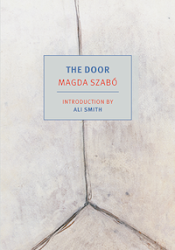I have been thinking a lot about doors this week, what doors are closing, what doors are opening. It is a time of great change for me personally, for my country, for the world.
Szabó’s brilliant novel opens with a recurring nightmare of desperately trying to force a door open; there is someone inside who needs saving. Yet she cannot even call for help; she has no voice.
The narrator of this first-person story is a Hungarian writer, also named Magda. She and her husband, also a writer, have no children, indeed no family, for Magda’s mother has recently died. After 10 years, the government has finally lifted its restrictions on Magda’s writing and, overwhelmed with opportunities, Magda decides to hire a housekeeper. Thus, Emerence enters their lives.
A sturdy older woman, Emerence takes control of the interview, announcing that she will decide whether to work for them, rather than the other way around. With great physical strength and an unrivalled understanding of how the world works, she performs herculean tasks to maintain the apartment building where she lives, clearing the snow for 11 buildings, providing meals for the sick, finding homes for stray animals, and the many other duties she has assumed.
Emerence is proud of her role as the bulwark of the neighborhood. She is the one they turn to with their problems, holding court on her front porch with strong tea or coffee. However, no one is allowed inside her apartment, which Magda calls the Forbidden City. This is only one of many mysteries about this remarkable woman. Did she steal the valuables Jewish neighbors had to leave behind when they were rounded up during the war? Did she kill a man and bury him in the back yard? Who is the young woman whose arrival she anxiously awaits?
Magda and Emerence frequently clash, more and more violently as they grow closer. Emerence has a laborer’s contempt for the idea that tapping on a typewriter could be considered work. She disapproves of Magda’s faith and criticises her when she attends church services. In her turn, Magda dismisses many of Emerence’s gifts as not being up to her standards and resents the way Emerence has appropriated the love and obedience of Magda’s dog.
Miscommunications and misunderstandings plague the relationship. In one hilarious scene, Magda takes Emerence to where a film is being shot, thinking to give her a treat. Upon learning that there are machines making the tree branches dance during a passionate love scene, Magda is disgusted and accuses Magda and the other filmmakers of being liars and cheats. Magda asks her, “‘Don’t you think it’s a function of art to create the illusion of reality?’” Emerence’s response changes how Magda understands her own art.
“Art . . . If that’s what you were—artists—then everything would be real, even the dance, because you would know how to make the leaves move to your words, not to a wind machine or whatever it was.”
Neither woman is spared in this brutal, yet subtle work. Every page reveals Szabó’s profound understanding of human behavior and motivations. I am grateful for the work of translators like Len Rix and publishers like New York Review Books for enabling me to read novels from other countries such as this one.
The book works on many levels. Some have seen it as old Hungary versus new Hungary or peasant versus educated elite. Perhaps it traces the difference between art and physical labor. In the end, though, it is a story about how difficult it is to love someone, and how necessary.
Have you read a book translated from another language? What did you think of it?

